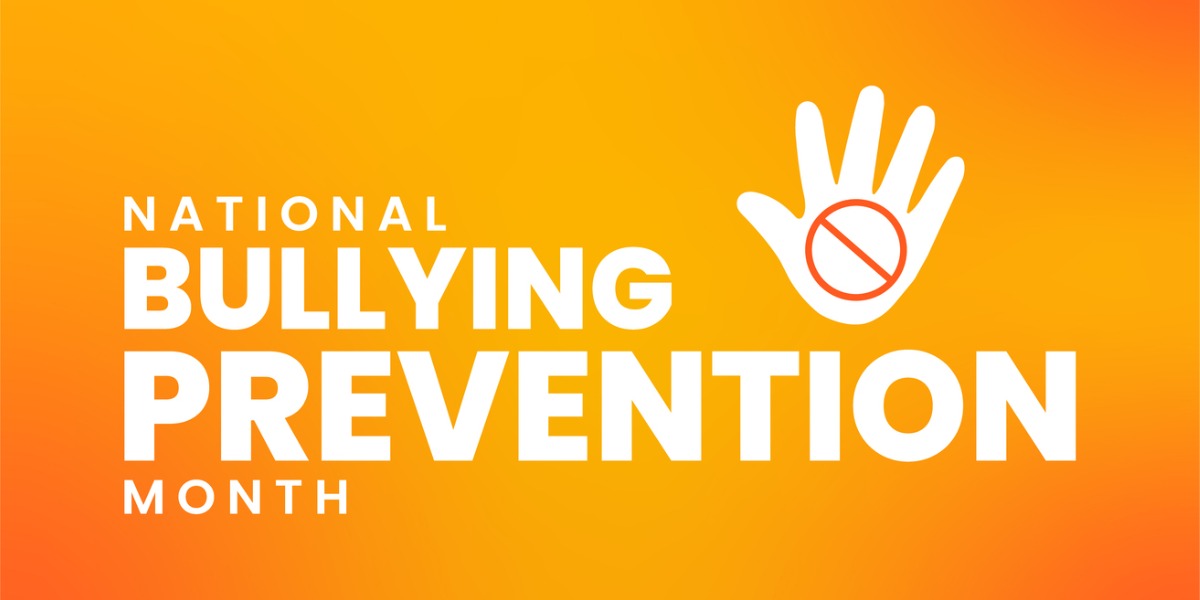Summary: To help during bullying prevention month, which occurs every October, you can learn the facts about bullying, share them with your kids, and teach your kids how to handle bullies and how to intervene when they see someone being bullied.
Key Points:
- October 2025 is Bullying Prevention Month
- October 10th is World Day of Bullying Prevention® An initiative of STOMP Out Bullying®
- Experiencing bullying during youth or childhood is considered an Adverse Childhood Experience (ACE) and can lead to lifelong physical, emotional, and psychological problems
- Evidence shows intervening immediately can stop bullying while it’s happening
What is Bullying Prevention Month?
Every year since 1999, government and non-profit groups have organized Bullying Prevention Month. In 2025, entities including STOMP Out Bullying®, the National Child Traumatic Stress Network, the advocacy group WeAreTeachers, and the National Bullying Prevention Center are taking the lead to promote the goal of Bullying Prevention Month.
There are four main goals for raising awareness during Bullying Prevention Month:
- Prevent all types of bullying, including cyberbullying
- Prevent discrimination, racism, and homophobia often perpetuated by bullying
- Reduce and prevent school violence
- Increase kindness, empathy, and compassion for others
Those are the goals of this important month. Here’s the theme for Bullying Prevention Month 2025:
Let’s #BeKind
Here’s how the advocates at STOMP Out Bullying® describe this year’s theme:
“Kindness is the quality or state of being kind. It is so important. The last few years we have endured such hate. We must get back to kindness. Give kindness because you can. Do not judge. Learn other cultures because if you don’t, you’ll never know what wonderful people can be in your life. Be respectful to all people. Why? Because the world needs more people who are. And there is no one better to do this than all of us.”
That’s a theme we can support one hundred percent. If you want to know what you can do to help during bullying prevention month, the first thing to do is familiarize yourself with the information we share below.
What is Bullying?
The Centers for Disease Control CDC defines bullying as follows:
“Any unwanted aggressive behavior(s) by another youth or group of youths, who are not siblings or current dating partners. It involves an observed or perceived power imbalance, and is repeated multiple times or is highly likely to be repeated. Bullying may inflict harm or distress on the victim including physical, psychological, social, or educational harm.”
The CDC identifies the following types of bullying:
- Physical bullying: pushing, punching, kicking, spitting
- Verbal bullying: insults, threats, teasing
- Social/relational bullying: spreading rumors, social exclusion
- Vandalism-related bullying: causing damage to personal property at school or in community
- Cyberbullying: any bullying that occurs via text, computer, or social media
In addition, the CDC indicates that parents, teachers, and policymakers should understand this fact:
Anyone can be a victim or bullying, a perpetrator of bullying, or both. A bullied person may bully others, a person who bullies may themselves be bullied. Experience of one does not categorically exclude the possibility of experiencing the other.
With that definition clearly in mind, let’s learn how many kids experience bullying in any given year.
Bullying Facts: The Who, What, When, Where, and How of Bullying
Data from the 2023 Youth Risk Behavior Survey (2023 YBS) published by the Centers for Disease Control (CDC) shows the most up-to-date data on bullying in the U.S.
Prevalence of Bullying: Middle and High School Students in 2023
Total:
- Reported being bullied, any type: 19.2%
- Middle School: 26.3%
- High School: 15.7%
- Bullied repeatedly, middle or high school: 14.5%
- Didn’t go to school at least once out of fear of bullying: 13%
- Among cisgender heterosexual students; 10%
- Among LGBTQIA+ students: 19%
By Gender:
- Girls: 21.8%
- Boys: 16.7%
By Whom?
- Students with some form of power: 15.5%
- Someone who could influence their social standing: 56.3%
- More popular students: 52%
- Physically stronger students: 39.7%
How Many Days Per Year?
- One: 32.5%
- Two: 17.6%
- Three to Ten: 31.5%
- More than ten: 18.5%
Cyberbullying/Online Bullying:
- Via computer or text: 21.6%
- Girls: 27.7%
- Boys: 14.1%
- Via computer, e.g. direct message, social media post or comment: 16%
- Girls: 21%
- Boys: 12%
Bullied Where?
- In the hall or stairs: 37.5%
- In class: 39%
- At lunch: 25.1%
- Outside of school: 24.4%
- In the restroom and/or locker room: 11.9%
- In the gym: 10.8%
- On the bus: 9.8%
Bullied in What Way?
- Rumors: 13%
- Direct insults: 11.9%
- Pushing, shoving, tipping, hitting, spitting: 4.9%
- Social exclusion: 3.7%
- Physical threat: 3.3%
- Private info, including photos, shared without consent: 2.5%
- Forced to do things: 2.5%
- Personal property destroyed: 1.4%
Those are the latest facts on bullying in the U.S. If you think your child is being bullied, the CDC indicates it’s important to know and watch for the following warning signs:
- Sudden unexplained injuries
- Missing or damaged books, personal electronics, clothes, backpacks, jewelry
- Persistent unexplained headaches, stomachaches
- Feigning illness to avoid school
- Sudden decline in academic performance
- Loss of interest in school
- Loss of interest in socializing
How to Help During Bullying Prevention Month
Everyone can play a role in reducing and preventing bullying. We’ll share the best advice, provided by the advocacy groups we cite throughout this article, for both parents and kids who want to help reduce and prevent bullying during bullying prevention month.
How to Help During Bullying Prevention Month
As a parent, you can:
- Teach. Talk to your kids about what bullying is and how to handle it in the moment. Share and discuss facts from this resource.
- Communicate. Check in with your kids abut what’s happening at school. Engage in active listening to ensure you really hear what they say.
- Inspire. Encourage your kids to participate in activities they love. This increases the likelihood they’ll meet and form bonds with kids with similar interests, which can reduce the likelihood of experiencing bullying.
- Walk the Walk. Model appropriate behavior. If you treat the people around you with respect, kindness, and compassion – including family, friends, and people in the world such as cashiers, customer service representatives, and servers in restaurants – your kids are likely to follow your lead.
As a student – school age, middle school age, or high school age – you can help by changing from a bystander to an upstander.
How to Be an Upstander: Bullying Prevention
- Ask What’s Up. Evidence shows simply engaging in a bullying situation from the outside by asking open-ended questions can stop bullying situations from escalating.
- Redirect. After asking, making a joke can change the entire situation: kids say this works.
- Get Friends to Help. A group of upstanders asking what’s up and engaging to interrupt can be more effective than one solo upstander.
- Stick Around. If you de-escalate a bullying situation by becoming an upstander, stay around and accompany the person you helped until they’re safe and okay. Also, consider accompanying them regularly at the same time and spot.
- Follow up. Later that day, the next day, or the following week, check in with the person you helped to see how they’re doing.
To learn more about becoming and upstander, download this resource:
Upstanders are Essential to Bullying Prevention and Intervention
Please remember that, in addition to stepping in to stop bullying when we see it happening, we can proactively reduce bullying by promoting the theme for Bullying Prevention Month 2025 every day of the year:
Let’s #BeKind
If we lead with kindness, commit to kindness, and promote kindness from early childhood onwards, we can increase our chances of stopping bullying behavior before it starts.


